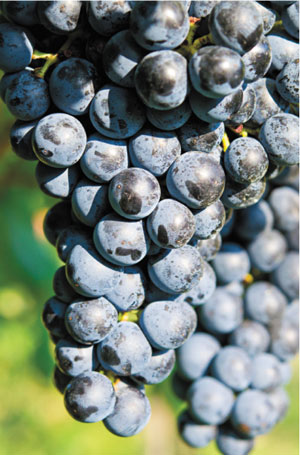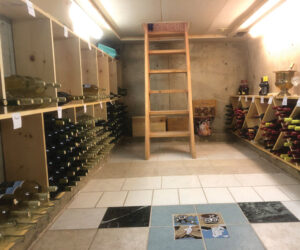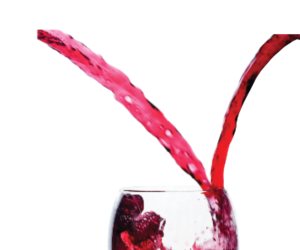
Grape skins play a pivotal role in producing red wines and a lesser role in rosé and white wines. For red wines, the compounds found in them will contribute key coloring compounds as well as flavor and structure to the finished product. The vast majority of these compounds fall into a broad family known as phenolics. The phenolic compounds contained within grape skins can be divided into broad groupings, flavonoids and non-flavonoids. Flavonoids are well-known in the wine (and biological) world with two of the most studied classes being anthocyanins (coloring) and tannins (mouthfeel and structure). The non-flavonoids are less well-known compounds, but some may recognize phenolic acids and stilbenoids (like resveratrol). So now that we have the chemistry names sorted and classified, we can focus on what grape skins do, how they can help or hurt your wine, how to handle them, and finally how best to dispose of them.
Key Phenolics
Not all grape skins are built alike and can have vastly different amounts of the phenolic compounds introduced in the last section. For example, anthocyanins are nearly absent — having been bred out of them — in grapes that are golden-green when ripe. Anthocyanins provide a mix of blue, red, and purple, giving red grapes and wines their characteristic color. White wine grapes in general will have lower anthocyanin content compared to most red wine grapes, even when they do appear fairly red when ripe . . . think ripe Pinot Gris that appears rosy-red to light purple.
When it comes to tannins, what you need to understand is that not all tannins are alike. Author Clark Smith compared tannins to snowflakes in that no two are alike. Tannins are actually chains (polymers) of a base flavonoid compound and its length will often determine the characteristic of the tannins in wine. Shorter tannins in general are found more so in young grape skins and grape seeds. Shorter tannins are often more harsh or rough on the palate with an associated bitterness. Tannins in the skin will polymerize (lengthen) as the grape ripens. The longer tannins will provide more astringency (a well-known drying sensation on your palate) and be much less harsh. Tannins will continue to polymerize during an extended aging period of the finished wine. The polymerization process will continue until the chain is too heavy to remain in suspension and will precipitate out of solution. Just like anthocyanins, different grape varieties will have varying amounts of tannins in the skin. Varietals like Tannat (notice the name similarity) are well known for producing high levels of tannins in their skins and may require extended aging times to allow polymerization to reduce its levels.
Key Factors
The size of the average grape berry plays a factor because it will determine the percent of grape skin, and its associated phenolic compounds, compared to the grape’s pulp. This is a big reason a small-berried variety like Cabernet Sauvignon can produce such bold wines, rich in color and tannins. While in theory small berries will have a higher grape skin-to-grape pulp ratio and will produce wines with higher total phenolic content per grape cluster, the reality is that the grape variety and place where it is grown has a greater impact than simply saying “small berries produce the richest wines.” Also skin thickness can play a contributing role, as not all grape skins are similar in this aspect. Grapes like Pinot Noir are notorious for being thin-skinned. Thinner skins will have less phenolic compounds to offer up.
Maceration concepts
For red wines, the maceration (soak period with grape juice and mashed grape solids) is where the magic happens — when the extraction of these key phenolics occurs. Anthocyanin extraction occurs quickly and can be complete in 36–48 hours. Tannins take a longer period with phenolic concentration still on the rise after two weeks. But in this scenario, winemakers need to balance the phenolics most winemakers want from the grape skins being extracted versus the phenolics from the grape seeds that most winemakers want to limit. For more on maceration decisions for red wines, I recommend: https://winemakermag.com/article/new-skills-master-maceration
For white wines, winemakers may opt to go to press just after crushing the grapes. Some may not even crush at all (whole-cluster press) in order to minimize phenolic extraction from the grape skins since grape skin phenolics are not often a desired component of white wines. But some white and rosé wines will experience a shortened maceration period. Aromatic whites, like Riesling, Viognier, and Chenin Blanc will gain beneficial compounds during this contact time. For a rosé, it’s time to press once the winemaker is happy with the color of the juice.
Once Pressed
Once the juice has been pressed, you need to figure out how to dispose of the grape solids that remain a.k.a. the grape pomace. This may not be too hard if you pressed 100 lbs. (45 kg) of grapes, but if you just pressed 1 ton (910 kg), it may be a challenge. If you have a vineyard or garden, mixing the pomace into the soil can get nutrients cycling back into the roots. But prior to mixing, a composting period should be done. If composting, just be sure to get them well mixed with plenty of nitrogen-rich material like leaves or paper. Do be aware of fruit flies; they love raw grape pomace and juice. Also, in areas that have municipal collection of compostable or yard waste materials, you may be able to include pomace in those special collection cans.
You can also look at doing a second-press run to get a second batch of wine from your red grapes. For more on that, I recommend the following: https://winemakermag.com/technique/620-second-runs-to-get-more-from-your-grapes-techniques.







